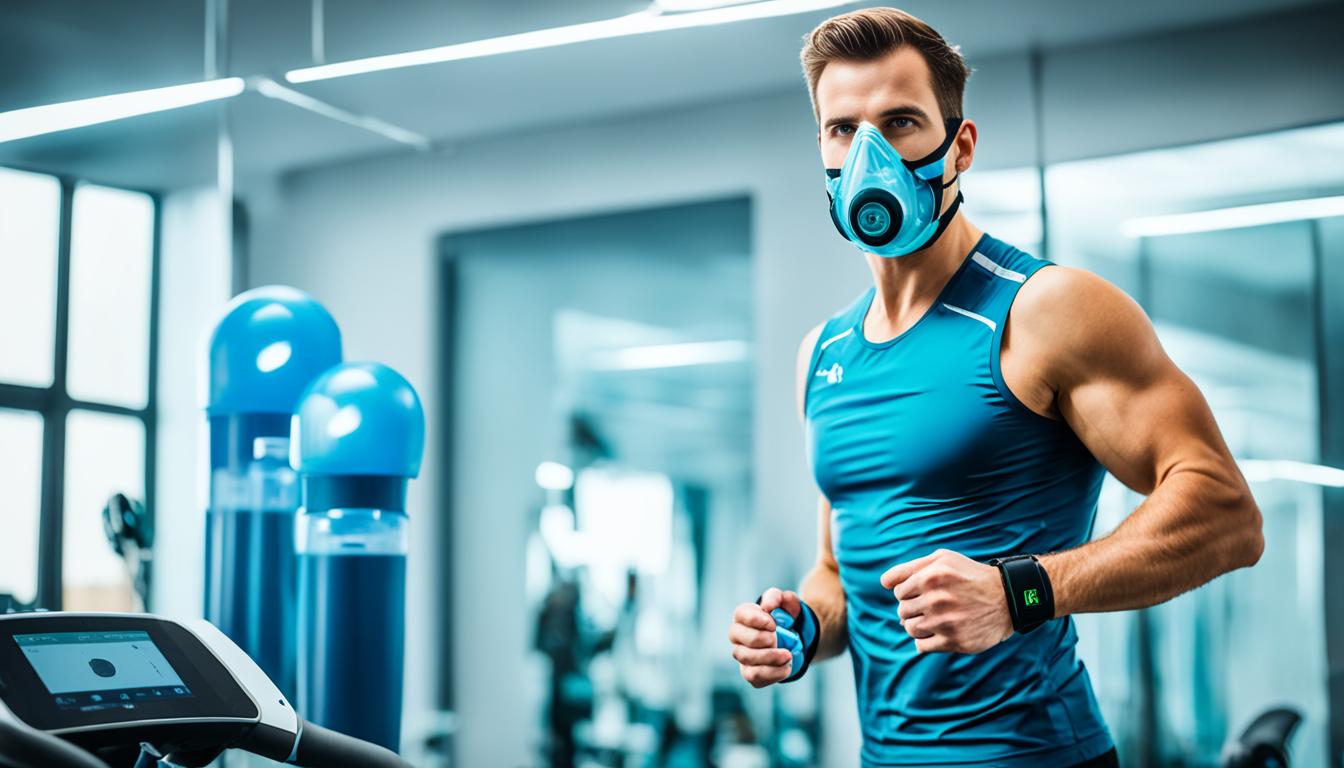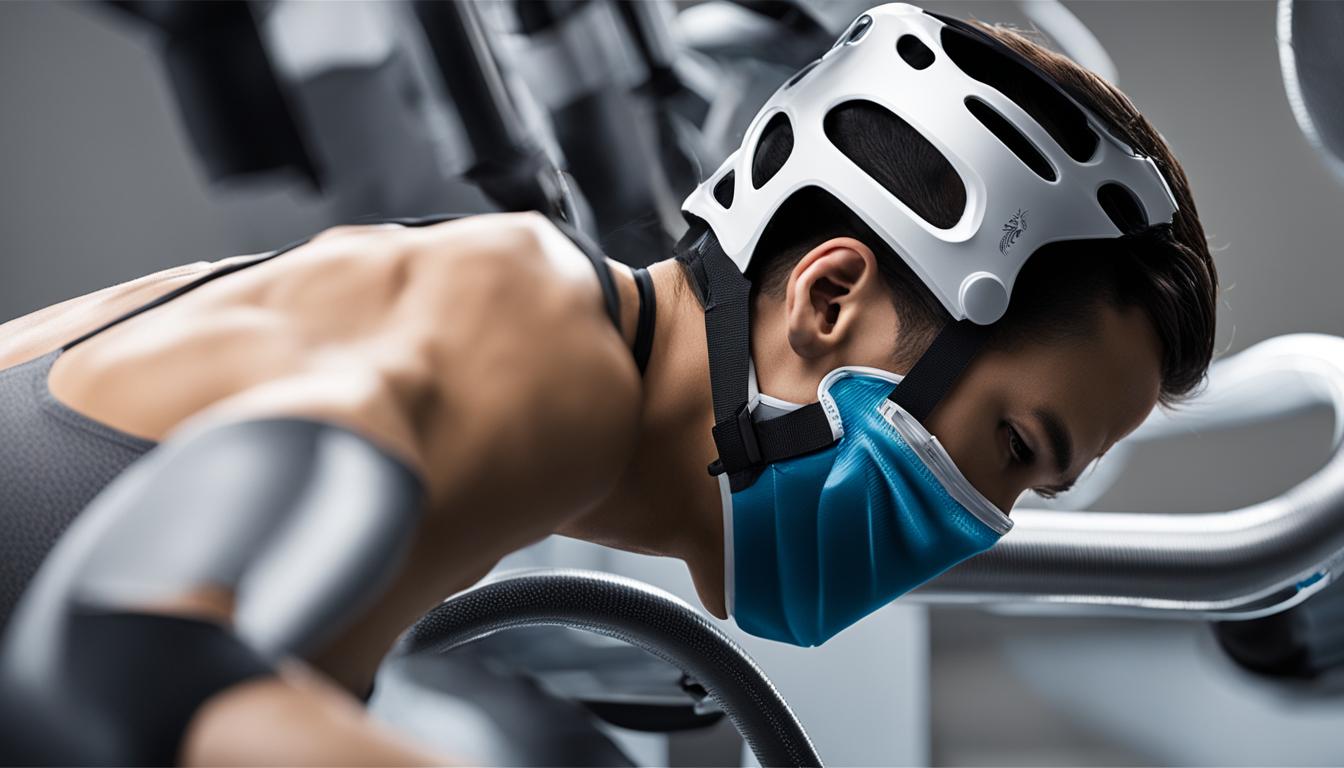Have you ever wondered how athletes and mountaineers prepare their bodies to withstand the effects of altitude? How do they train to perform at their best when oxygen levels decrease? The answer lies in the use of a fascinating device called a hypoxic generator. This innovative technology allows individuals to create hypoxic conditions, simulating high-altitude environments with reduced oxygen levels. But how exactly does it work? Let’s dive into the science behind hypoxic generators and explore the benefits of hypoxic training.
Key Takeaways:
- A hypoxic generator is designed to simulate high-altitude environments with reduced oxygen levels.
- By living or training in a hypoxic environment, the body adapts to lower oxygen content, leading to improved performance when returning to lower altitudes.
- Hypoxic generators are used by athletes to enhance their endurance, adapt to high altitudes, and prevent altitude sickness.
- Altitude tents, powered by a hypoxic air generator, are a convenient alternative to actual high-altitude training camps.
- Hypoxic training stimulates the production of more red blood cells, improving the body’s ability to deliver oxygen to the muscles.
Altitude tent history and rationale
Altitude tents have a rich history and serve as a vital tool in altitude training for athletes. Introduced in the mid-1990s, these innovative tents, also known as normobaric altitude tents, provide a unique environment that simulates high-altitude conditions while athletes train at sea level.
The rationale behind altitude tents is to allow athletes to experience the physiological benefits of training at high altitudes without the need to physically be at high elevations. These tents create an altitude-simulating environment by reducing the oxygen concentration in the air while preserving the ambient air pressure.
The key component of altitude tents is the hypoxic air generator, which pumps low-oxygen air into the tent, replacing some of the oxygen with nitrogen. This process creates an environment that closely resembles the oxygen levels found at higher altitudes. The use of normobaric tents ensures that athletes can train in a low-oxygen environment without compromising air pressure.
The benefits of using altitude tents for training are significant. Athletes can achieve adaptations to high altitude, such as increased red blood cell production and improved oxygen delivery, without the constraints of being in a real high-altitude location. This allows athletes to enhance their performance and endurance while reducing the risk of altitude-related health issues.
In summary, altitude tents have revolutionized the way athletes train, providing a practical and convenient solution to achieve altitude adaptation without the need for physical relocation. The optimization of oxygen concentration and the normobaric environment make altitude tents an invaluable tool in the field of altitude training.
Operation of a hypoxic generator
Hypoxic generators play a crucial role in creating altitude-simulating environments for training purposes. These generators operate by reducing the concentration of oxygen in the air inside the tent, mimicking conditions experienced at higher altitudes.
In a typical altitude tent, the oxygen concentration can be as low as 12%, with the remaining composition consisting of nitrogen. This reduced oxygen concentration stimulates a physiological response in the body, triggering various adaptations to enhance performance.
When exposed to lower oxygen levels, the body responds by increasing red blood cell production, which improves the delivery of oxygen to the muscles. To elicit this physiological response, the altitude set in the tent must be sufficient to reduce blood oxygen saturation to around 90%.
By training or living in this hypoxic environment, athletes and individuals can experience the benefits of altitude adaptation without the need to physically ascend to high altitudes. The adaptations achieved through hypoxic generator operation can enhance athletic performance and promote physiological improvements.
| Benefit of Hypoxic Generator Operation | Description |
|---|---|
| Increased Red Blood Cell Production | Exposure to lower oxygen levels stimulates the production of red blood cells, enhancing oxygen-carrying capacity. |
| Improved Oxygen Delivery | More red blood cells result in better oxygen delivery to the muscles, improving endurance and performance. |
| Enhanced Altitude Response | The body’s ability to adapt to high altitudes is enhanced through exposure to hypoxic conditions, improving performance at altitude. |
| Physiological Effects | Hypoxic training can elicit various physiological adaptations, promoting better oxygen utilization and overall fitness. |
With hypoxic generator operation, individuals can unlock their full potential by enhancing their body’s oxygen utilization, endurance, and acclimatization to altitude. This innovative technology provides a convenient and effective means of achieving altitude-related benefits.
Types of altitude tents
Altitude tents come in a variety of styles to cater to different individual needs. Unlike regular camping tents, altitude tents are designed with limited ventilation and often feature clear plastic windows rather than mesh vents. This unique design helps to create a controlled environment where the oxygen concentration can be reduced to simulate higher altitudes.
The ventilation system in an altitude tent plays a crucial role in maintaining the desired air quality. While limited ventilation helps to retain the reduced oxygen levels, it is essential to ensure adequate air exchange to prevent heat and humidity buildup and carbon dioxide buildup.
To deliver the reduced oxygen air, altitude tents are typically equipped with hoses that are connected to a hypoxic air generator placed outside the tent. This setup helps to minimize noise while ensuring a constant supply of low-oxygen air.
Altitude tents vary in size and configuration. Smaller tents can be placed on the bed, allowing users to experience altitude conditions while sleeping. Larger tents, on the other hand, are cube-shaped and set up on the floor, with the entire bed placed inside. This design provides a more spacious environment for users to move around and perform exercises.
Advancements in altitude tent design, as well as hypoxic air-supply units, have addressed previous concerns related to heat, humidity, and noise levels. These improvements in air exchange and noise reduction have made altitude tents more comfortable and effective for training purposes.
Key Features of Altitude Tents:
- Limited ventilation to retain reduced oxygen levels
- Clear plastic windows for visibility
- Hoses for air delivery from an external hypoxic air generator
- Smaller tents for bed placement and larger cube-shaped tents for floor placement
- Improved air exchange and noise reduction
Benefits of hypoxic training
Hypoxic training offers several benefits for athletes, enhancing their athletic performance and improving their overall fitness. By exposing the body to reduced oxygen levels, hypoxic training stimulates the production of more red blood cells, which enhances the oxygen-carrying capacity of the blood.
This increase in red blood cell production leads to improved oxygen delivery to the muscles and organs, resulting in enhanced endurance and performance. Athletes who incorporate hypoxic training into their regimen often experience faster recovery times and increased stamina during intense physical activity.
Furthermore, hypoxic training helps athletes acclimatize to high altitudes, where oxygen levels are lower. This adaptation allows athletes to perform better at altitude and can prevent altitude sickness, which can significantly impact performance in mountainous regions or high-altitude competitions.
One of the key advantages of hypoxic training is that athletes can reap the benefits of altitude training without the need to travel to high-altitude locations. Instead of spending extended periods of time training in mountainous regions, athletes can create a hypoxic environment in the comfort of their own homes using altitude tents or other similar devices.
Overall, hypoxic training offers athletes the opportunity to enhance their athletic performance, increase their red blood cell production, improve their oxygen delivery, and acclimatize to altitude, all without the need for expensive and time-consuming travel to high-altitude locations.
“Hypoxic training has transformed my athletic performance. The increased red blood cell production and improved oxygen delivery have greatly improved my endurance and recovery time. I now feel more prepared than ever to tackle high-altitude challenges and competitions.” – Samantha Davis, Professional Athlete
Ethical considerations and debates
When it comes to altitude training, there are ethical concerns that have sparked debates among experts and organizations like the World Anti-Doping Agency (WADA). Some argue that the use of altitude tents in sports may provide similar benefits to banned practices like blood doping. The concern is that altitude tents could potentially enhance performance in an unfair and unethical manner.
“Altitude tents should be banned as they provide an advantage similar to blood doping,” some claim. Blood doping involves artificially increasing red blood cell count to enhance oxygen-carrying capacity and endurance. Critics argue that altitude tents may yield similar physiological adaptations and therefore should be subject to the same ethical scrutiny.
However, it’s important to note that the consensus among health, medicine, and research committees differs from this viewpoint. As of now, altitude tents are not considered equivalent to blood doping, and therefore, they are not banned by WADA. While altitude tents can stimulate adaptations that enhance performance, they do so through natural physiological responses to reduced oxygen levels, rather than artificially manipulating blood parameters.
There is also a discussion about the potential for altitude tents to mask the use of performance-enhancing substances, such as erythropoietin (EPO). Altitude training can increase the body’s production of natural EPO, which raises concerns about its use as a cover for doping practices. This debate highlights the need for ongoing research and monitoring to ensure fairness and integrity in sports.
“Altitude tents offer a unique training environment that stimulates physiological adaptations. While they may raise ethical questions, they are currently considered distinct from banned practices like blood doping.” – Dr. Anna Thompson, Sports Medicine Expert
Debunking the Blood Doping Comparison
It is essential to differentiate altitude training using tents from blood doping. While both practices can enhance athletic performance, their mechanisms and ethical implications are distinct. Blood doping involves the artificial manipulation of blood parameters, such as red blood cell count or oxygen-carrying capacity, through the use of prohibited substances or procedures. Altitude training, on the other hand, creates a hypoxic environment to stimulate natural adaptations in the body.
Blood doping has been widely condemned due to its potential health risks and unfair advantage over athletes who do not engage in such practices. Altitude training, when conducted within ethical boundaries, offers athletes a legitimate way to improve their performance through natural physiological responses.
Ethical Monitoring and Regulation
Given the ongoing debate surrounding altitude training ethics, it is crucial for sports organizations, regulatory bodies, and researchers to continue monitoring the use and effects of altitude tents. Striking the right balance between providing athletes with opportunities for enhancement while ensuring fair play and preserving the spirit of competition remains a challenge.
The World Anti-Doping Agency, along with other relevant authorities, should continuously assess the effectiveness and potential risks of altitude training methods. This includes examining the relationship between altitude training and increased natural EPO production to prevent misuse and abuse.
Educating athletes, coaches, and medical professionals about the ethical considerations of altitude training can also play a vital role in maintaining integrity within sports. Promoting an understanding of the differences between legitimate altitude training practices and banned doping methods helps ensure that athletes make informed choices and compete fairly.
| Ethical Concerns of Altitude Training | Counterarguments |
|---|---|
| Comparison to Blood Doping | Altitude training stimulates natural physiological responses rather than artificial manipulation. |
| Potential Masking of Doping | Strict monitoring and regulation can address misuse and abuse. |
Personal experiences with altitude tents
When it comes to altitude tents, personal experiences can vary greatly. While some individuals report positive effects, particularly those who struggle at high altitudes and experience symptoms such as altitude sickness, others may not find the same benefits.
For those who have difficulty acclimatizing to high altitudes, using an altitude tent can be a game-changer. The tent provides an opportunity to adapt to higher altitudes gradually, allowing individuals to perform better and alleviate the symptoms they typically experience. Through pre-acclimatization, altitude tents enable users to overcome the challenges posed by high altitudes and improve their overall performance.
“Using an altitude tent has transformed my experience at high altitudes. Before, I would constantly feel sick and fatigued. Now, with the tent, I am able to adapt beforehand and enjoy the outdoors without any discomfort. It has made a significant difference in my performance as well.”
However, the effectiveness of altitude tents can depend on individual responses to altitude and their specific goals. Athletes looking for pre-acclimatization before competing at high altitudes may benefit from using altitude tents, as it can give them a competitive advantage. On the other hand, those who primarily train at sea level may not experience substantial gains from using altitude tents. It ultimately comes down to the individual’s physiological response and the desired outcomes.
It is important to note that altitude tents are just one method of acclimatizing to altitude and should be used in conjunction with other altitude training strategies for maximum effectiveness.
Benefits of Pre-Acclimatization
Pre-acclimatization through altitude tents offers several benefits. By simulating the low-oxygen environment at higher altitudes, the body undergoes physiological adaptations that enhance performance and endurance. These adaptations include increased red blood cell production, improved oxygen delivery to the muscles, and enhanced overall aerobic capacity.
Moreover, pre-acclimatization with altitude tents allows athletes to experience the benefits of altitude training without the need to travel to high-altitude locations. This convenience saves time and resources while still providing the desired physiological adaptations.
Individual Response to Altitude
It is important to recognize that each individual responds differently to altitude and altitude training methods. Some individuals naturally have a higher tolerance for high altitudes, while others may struggle even with pre-acclimatization. Factors such as genetics, fitness level, and overall health can influence an individual’s response to altitude.
Therefore, it is essential to assess individual goals, consult with professionals, and monitor the response to altitude training methods like altitude tents. By tailoring the approach to the individual’s needs, it is possible to optimize the benefits and outcomes.
Now let’s take a closer look at some personal experiences with altitude tents:
- An athlete mentions how altitude tents have revolutionized their training routine by allowing them to adapt to higher altitudes, resulting in improved performance and reduced symptoms of altitude sickness.
- A mountaineer recounts how using an altitude tent has made a significant difference in their ability to acclimatize before expeditions, helping them to overcome the challenges posed by high altitudes.

| Participant | Experience |
|---|---|
| Athlete A | The altitude tent has greatly improved my performance at high altitudes. I no longer experience fatigue and can push myself further. |
| Mountaineer B | Using the altitude tent has made a remarkable difference in my ability to adapt to high altitudes. It has helped me overcome altitude sickness and perform better during expeditions. |
Comparison to other altitude training methods
Altitude training offers athletes various methods to improve their performance and adapt to high-altitude conditions. While altitude tents provide a convenient alternative, it is important to compare them to other training methods such as actual high-altitude camps, hypoxic training, and hyperoxic training. Each method presents unique physiological stressors and benefits, catering to different training goals and individual needs.
Actual High-Altitude Camps
Actual high-altitude camps involve training at elevated locations where oxygen levels are naturally lower. This method exposes athletes to the real physiological stressors of altitude, including decreased oxygen availability. By spending a considerable amount of time at high altitudes, athletes can adapt to the oxygen-deprived conditions, leading to improved performance when returning to lower altitudes. High-altitude camps are often preferred by those who seek a comprehensive and immersive altitude training experience.
Hypoxic Training
Hypoxic training, which can be carried out using altitude tents, focuses on creating a reduced oxygen environment to simulate high-altitude conditions. By exposing the body to these lower oxygen levels, hypoxic training stimulates physiological adaptations such as increased red blood cell production and improved oxygen delivery to the muscles. Hypoxic training enables athletes to reap the benefits of altitude training without the need to physically train at high altitudes. However, it is essential to monitor and control the physiological stressors induced by hypoxic training to prevent excessive strain on the body.
Hyperoxic Training
On the other hand, hyperoxic training involves training in an environment enriched with higher oxygen levels than normal atmospheric conditions. This method aims to increase the availability of oxygen to the body, potentially enhancing aerobic performance. Hyperoxic training can be beneficial for athletes seeking to maximize oxygen delivery to the muscles during training sessions. However, it is essential to note that hyperoxic training may differ in its physiological effects compared to altitude training and hypoxic training.
Summary
While altitude tents offer athletes a convenient alternative to actual high-altitude camps, it is crucial to consider individual goals, needs, and training requirements when choosing an altitude training method. Hypoxic training with altitude tents provides a feasible option for athletes who cannot attend high-altitude camps while still benefiting from adaptive physiological responses. Additionally, hyperoxic training can offer advantages by increasing oxygen availability. Ultimately, finding the most suitable altitude training method would depend on factors such as training goals, time constraints, and individual physiological responses.
Considerations for using altitude tents
When contemplating the use of altitude tents for training or acclimatization purposes, it is crucial to consider several factors. The decision should be guided by individual goals and needs, as altitude tents may not yield the same benefits for everyone. Individualize your approach based on your specific objectives, whether that is improving athletic performance or preparing for high-altitude environments.
Additionally, the cost of the equipment should be taken into account. Altitude tents can represent a significant investment, and it is essential to assess whether the potential benefits justify the expenditure. Researching different brands and models can help make an informed decision.
Air quality and comfort inside the tent are also key considerations for an optimal training experience. Proper ventilation is crucial to maintain a fresh air supply and prevent carbon dioxide buildup. Monitoring and controlling factors such as heat and humidity can contribute to a more comfortable environment. Ensuring the tent provides a comfortable and inviting atmosphere maximizes the benefits of training in simulated altitude conditions.
Consulting with professionals who specialize in altitude training and considering individual circumstances is recommended when deciding whether to use an altitude tent. They can provide personalized guidance and expertise tailored to your specific needs. By weighing these considerations, you can determine whether incorporating altitude tents into your training regimen aligns with your goals and preferences.



